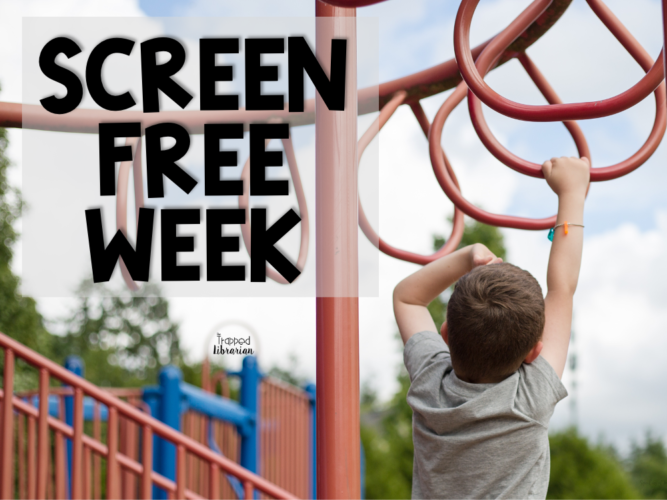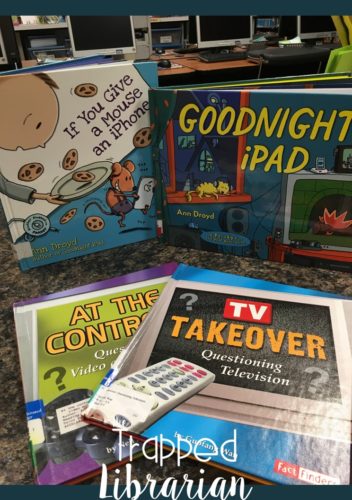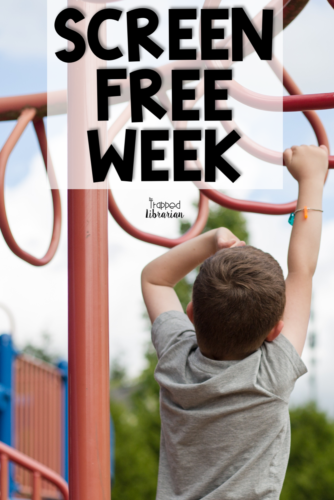Last Updated on May 10, 2025 by Laura

We loved celebrating Screen Free Week—formerly known as “TV Turnoff Week”—at my school and it was a great event for family engagement! Our screen free week activities challenge students to avoid using screens for entertainment and explore other ways to spend their time. Students who participate complete a contract and tracking sheet, get it signed by an adult, and earn ten raffle tickets for fun screen-free prizes like Ozobots, basketballs, art kits, and games. In recent years, we’ve started calling it Screen Time Awareness Week, and it’s become one of the most popular events in our school library!
This posts contains affiliate links for your convenience. This means that if you click one and make a purchase, I may receive a commission at no cost to you. Thank you for your support.
What is Screen Free Week?
Screen Free Week usually takes place at the end of April or beginning of May. It began as a simple challenge—just turn off the TV for a week—and we’d even suggest families tape the contract to their television as a reminder. But times have changed. Screens are now everywhere and essential to many daily tasks, from learning to communicating. That’s why screen free week activities today aren’t about cutting out all screens—they’re about encouraging students and families to reflect on how and why they use them.
Instead of abandoning the idea, we’ve adapted it. At our school, the focus is on Screen Time Awareness Week as a way to promote healthy digital habits. While some schools in our district have moved away from the event, I still believe it’s worth the effort. Helping students and families take a closer look at their screen use—even just for one week—can spark meaningful conversations and lasting changes. It’s not about perfection; it’s about awareness and making thoughtful choices.
Engaging Screen Free Week Activities
Thinking about implementing Screen Free Week at your school? Here are some simple, effective screen free week activities that have worked well for me:
1. Encourage families to set screen time goals.
Send home a simple contract a week in advance and ask students and their families to set priorities for reducing screen time. During the week, they can track their screen-free successes and return the signed form to earn participation rewards.
2. Offer screen-free inspiration through books.
Set up a themed book display to help students discover new hobbies and interests. Fill tubs with books on topics like learning a language, doing magic tricks, starting a craft, playing sports, solving puzzles, and more.
3. Create a collaborative bulletin board.
Inspire creativity with an interactive display. Invite students to brainstorm fun, screen-free ideas, then write or illustrate their suggestions on paper. Post them on a bulletin board in a central location—it’s a great way to build a culture of sharing and exploration.
Implementing Screen Free Week in Schools

There are many ways to make Screen Free Week meaningful and memorable in your school. Here are some practical ideas for the library that can spark thoughtful discussions and promote screen-free fun:
1. Read and discuss books that spark conversations about screen use.
Use your library lessons to read picture books and nonfiction titles that encourage students to reflect on their screen habits. Some favorites for sparking discussion include:
-
Good Night iPad and If You Give a Mouse an iPhone by Ann Droyd
-
When Charlie McButton Lost Power by Suzanne Collins
-
TV Takeover: Questioning Television by Guofang Wan
-
At the Controls: Questioning Video Games by Neil Andersen
2. Guide students in brainstorming screen-free activities.
Facilitate engaging library lessons where students generate ideas for screen-free fun. Try activities like:
-
Playing Screen Free Charades
-
Creating an ABC Taxonomy of screen-free ideas
-
Illustrating their ideas in a booklet
-
Writing suggestions on sticky notes to display on your interactive bulletin board
3. Add excitement with a reward system.
Encourage participation by offering small prizes to students who complete their Screen Free Week contract. I sent the contract home in advance (see #1 in the previous section), and those who returned it earn raffle tickets for fun prizes. My parent council helped fund prizes, and I also used Scholastic Dollars from our book fair to purchase items like Makey Makeys, Ozobots, sports gear, and craft kits. Prizes are given out during a fun, school-wide assembly!
Make it Easy With the Screen Time Awareness Bundle
Planning Screen Free Week activities doesn’t have to be time-consuming. I’ve created a resource that brings everything together for you!
The Screen Free Week Bundle includes everything you need to run a fun, meaningful event at your school:






Whether you’re new to Screen Free Week or looking to refresh your approach, this bundle can help you create a week your students will remember—and reflect on long after it’s over.
Grab it today and make your Screen Free Week simple, fun, and impactful!
 Save These Screen Free Week Ideas for Later!
Save These Screen Free Week Ideas for Later!
Pin this post so you’ll have fresh ideas and ready-to-use resources for your next Screen Free Week!
Be the light!




 Elementary School Librarian
Elementary School Librarian NBCT 2011
NBCT 2011 Teacher Author
Teacher Author Add some fun to your end of the year library
Add some fun to your end of the year library 
 Grab these fun Summer Boo
Grab these fun Summer Boo



 NEW PRODUCT!!
NEW PRODUCT!! 


 Grab
Grab